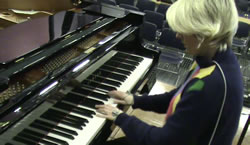Brief Thoughts on using Live Electronics
The Inside-out Piano and touring
I personally think the future of piano and electronics is for us to each have our own touring piano or at the very least, our own touring system (for example Sebastian Lexer’s Piano+ system). By touring piano, I don’t mean a Steinway or a Fazioli — I mean something which is personalised, which can be taken anywhere and which has its own inbuilt system. For me, this has actually become a necessity, since I invented the Inside-out piano. This instrument came about because I wanted to change the shape of the piano. I felt it was vital to better access the inside of the instrument: bored of standing with my back bent forward at 45 degrees to the vertical and arms outstretched, unable to play both pedals or see the keyboard once “inside” the grand piano, I decided to have a go at reinventing the instrument. The shape it is came about because I had hung up some soundboards in a warehouse studio and had started wondering about re-attaching the keyboard in a different place to normal. I took one of the boards down and put an action on the floor in front of it, to see how it might work.
It is extremely liberating designing an instrument, although my prototype is still rather basic! But it is a joy to play — physically very free and for the audience really eye-catching. The two main research points — to make it more accessible for both my hands and the audience’s eyes — have both been answered. What is really fascinating is that it is exactly the same shape as the old cabinet or giraffe pianos. Interesting to think that there was an appropriate “inside piano” instrument before that was done at all! I think reasons to have a touring piano include:
- the sonic possibilities of embedding the electronic sound within the instrument itself; or
- the sonic possibilities of embedding interactive technology, e.g. a motion capture / gesture recognition system.
And think of the freedom of not having to check with the piano technician or venue manager if it’s ok to play inside! Of course, travelling with a “touring” instrument can be hard when it isn’t light so my next important mission is to attempt to make the instrument lighter. I will hopefully be able to report back on this before too long.
Here are some of the wonderful touring pianists and pianos I have been collaborating with recently: Andrea Neumann’s “inside piano”, Pierre Malbos’ “Piano Baschet-Malbos”, Felix’s Machines and Kathy Hinde’s beautiful installations.
Please contact me if you are interested in re-inventing or re-building the piano, especially concerning technological applications. I am currently starting an event called “Scrap Piano Challenge” — one-day rebuilds of old pianos, making them into new sonic and sculptural creations.
Live Electronics with Normal Piano — My own Experiences
I’ve played with live electronics using lots of different systems, always seeking out the most intuitive or responsive. I’ve played in duos (e.g. with Richard Barrett and Michael Edwards), with motion sensors (Jonathan Green) and muscle sensors (Atau Tanaka); with “static” samples (Larry Goves) and with motors (working with Will Scrimshaw, Leafcutter John).


Working with the EMG sensors with Atau Tanaka was challenging as they require certain physical tension — muscles need to be contracted and tensed whilst playing. A new gestural language evolves around the performance and it feels as if one is playing two instruments at once almost: the external piano and the internal instrument of the body. As I found I really had to get used to playing the sensors first, I gradually stopped playing the piano and actually just practiced in mid-air. This really helped to find the physical language needed to create the desired sounds but after doing a performance with just the sensors (i.e. no piano) I had to stop myself. I had completely forgotten the original line of enquiry: to bring the two experiences into conversation; I had instead abandoned the keyboard for the freedom of mid-air. What was interesting here though was that, in showing my performance to theatre makers, I discovered they saw not the wonderful liberation of a pianist’s hands but instead the strangely static bottom half of a performer waving her arms around!! It was very instructive to hear their feedback: I would thoroughly recommend this at least once to anyone contemplating gesturally controlled electronics. Going back to the piano, I returned to the original research: to find a physical language that could be encompassed within — not sit on top of — piano technique. It was much more subtle, less agitated, much less theatrical than the states I had been exploring.
I’m now working on an improvisational system with Nick Gillian from SARC (Video 1) which we’ll present at NIME 2011. This is using gestural recognition in the space around the keyboard to create mid-air, virtual control points; the technology we’ll use is the Xbox Kinect.
Notating Live Electronics
A final thought: I think the notation of live electronics really needs improving, to better enable pieces to be passed around the community; I have found very few cases where the live electronics is notated enough to be useful. I personally find the pictorial representation of sounds in a wave formation very unhelpful, as a whole score can to all intents and purposes look quite the same throughout, when there may be a huge difference in actual sound. Instead, I have found the most successful to be either entirely notated, such as Larry Goves’ My Name is Peter Stillman. That is not my real name (2007), or a mixture of words and music — here, Pierre Alexandre Tremblay’s Un clou (2009) was extremely clear.
Social top